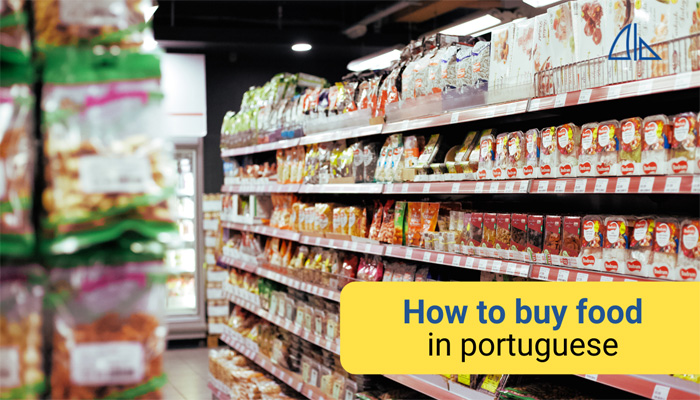Going to the grocery store in Portugal, we need to know not only what and where we want to buy, but also to specify the desire. In this article, we will take a closer look at this topic.
An object
The most important element when going to the store is the “lista de compras” (shopping list). To complete it, you need to know the correct names of some products in Portuguese. Moreover, in what container they are sold.
- lata de atum – can of tuna
- garrafa de vinho – bottle of wine
- pacote de leite – carton of milk
- caixa de chocolate – box of chocolate
- saco de batatas – bag of potatoes
If the name of any product can be found in the dictionary, then the combination of packaging and product is not always possible, so remember it.
A place
In our era, when absolutely everything can be ordered online, there is absolutely no need to go shopping from home. However, markets with fresh vegetables and fruits are still popular in Portugal. Let’s find out how these places of sale of food products are called in Portuguese:
- supermercado – supermarket
- mercado – market
- mercearia – grocery store
- padaria – bakery
- pastelaria – confectionery
- talho – butcher shop
With this information, we can tell about our purchases:Todos os dias eu compro uma garrafa de vinho verde num supermercado. (Every day I buy a bottle of green wine at the supermarket.)
A mãe da Maria levanta-se cedo, vai a um mercado e compra lá legumes frescos. (Mary’s mother gets up early, goes to the market and buys fresh vegetables there.)
Now we know how to say in Portuguese what and where we buy. How to specify a product or store?
Specificity
We are already familiar with the demonstrative pronouns “este, esse, aquele” and the prepositions “em, de, a“. To concretize the information, we will have to combine demonstrative pronouns and prepositions. Let’s see how:
| em + este | neste |
| em + esse | nesse |
| em + aquele | naquele |
| de + este | deste |
| de + esse | desse |
| de + aquele | daquele |
| a + este | a este |
| a + esse | a esse |
| a + aquele | àquele |
It is important to remember that:
the pronouns “este(a/es/as)” are for specific objects and people who are next to the speaking person;
the pronouns “esse(a/es/as)” – for specific objects and people who are near the listening person;
the pronouns “aquele(a/es/as)” – for specific objects and people who are far from both – and from the speaker, and from the listener.
Let’s see how to put this into practice:
O que vendem nesta loja? (What does this store sell?)
O João gosta muito desse supermercado. (João likes a lot this supermarket.)
Não quero ir àquela padaria. (I don’t want to go to that bakery.)
Of course, in this way you can concretize information about any place, object or person in any situation.
Verbs
To describe the location of an object or person, we use two verbs: “estar” and “haver“. But there is a fundamental difference in their use:
“estar” – when we indicate the temporary location of a an object or person;
“haver” – when we indicate the existence of a non-specific object or a person.
Examples will help you feel the difference between them:
A sopa está no frigorífico. (Soup is in the refrigerator.) – Object location
No frigorífico há uma sopa. (There is soup in the fridge.) – Object existence
As pessoas estão no mercado. (People in the market.) – People location
No mercado há pessoas. (There are people in the market.) – People existence
Moreover, the verb “haver” is impersonal and here we only use the form “há“.
Adverbs of place
Whether we go to a store or send someone to a store for a specific product, it is sometimes important to explain the details. The adverbs of the place will help us with this:
- atrás de – behind, behind
- em frente de – in front, in front
- em cima de – on top
- debaixo de – below, under
- ao lado de – near
- entre – between
Now you can explain which shelf to look for your favorite juice, for example, or describe the location of the store:
Podes encontrar cerveja entre garrafas de água e latas de coca-cola no Pingo Doce. (You can find beer between water bottles and Coke cans at Pingo Doce.)
O supermercado Lidl fica atrás do centro comercial e ao lado do hospital. (The Lidl supermarket is located behind the mall and next to the hospital.)
Using adverbs of place, you can describe the location of any object or person. They are often used, so remember them.
Some, several
You already know that Portuguese has the singular “o, a” and the plural “os, as” definite articles. And also there are indefinite “um, uma“. We don’t usually use plural indefinite articles, but there is such a form.
Tenho uns/alguns amigos nesta cidade. (I have several friends in this city.)
O meu pai tem umas/algumas máquinas de lavar roupa.
Posso vender-te uma. (My father has some washing machines. I can sell you one.)
As follows from the examples, we use the plural forms of the indefinite articles in Portuguese to mean “some, several“.
Conclusion
Of course, the information from this article can be used to communicate on any other topic. Despite the fact that the topic seems specific, there is a lot of useful information in it. And you will learn even more useful things in our lessons. Come to our school!
